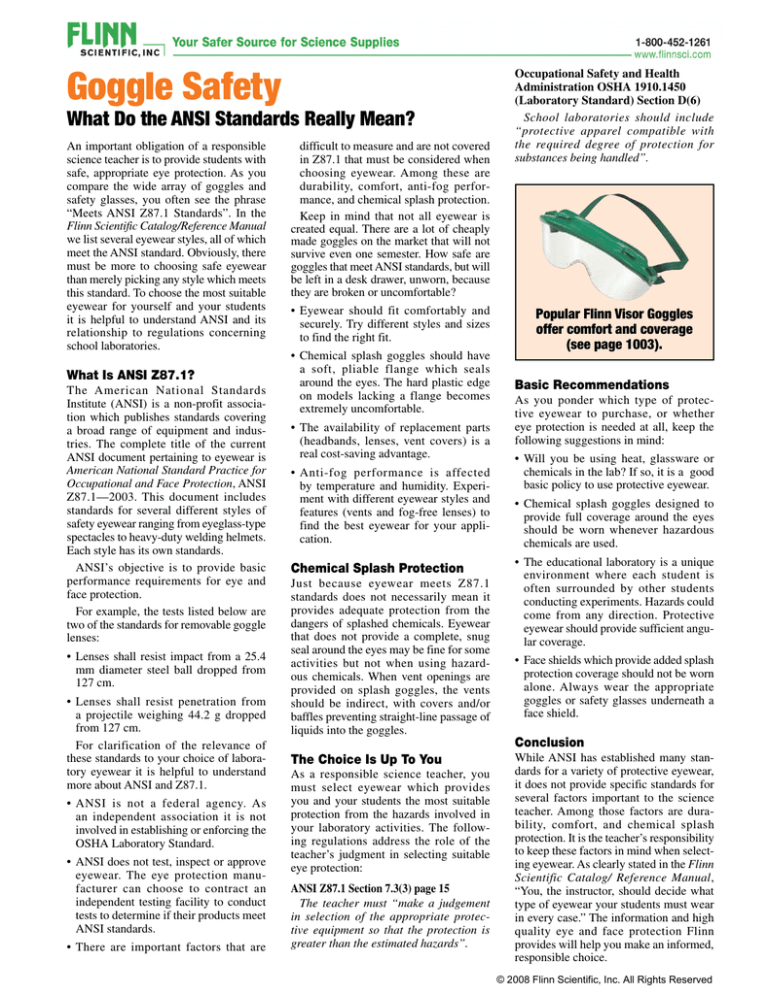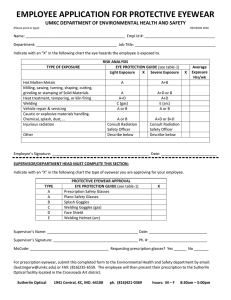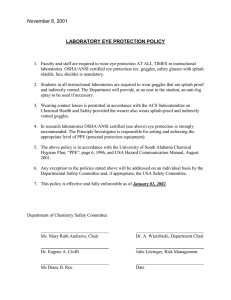
Goggle Safety
What Do the ANSI Standards Really Mean?
An important obligation of a responsible
science teacher is to provide students with
safe, appropriate eye protection. As you
compare the wide array of goggles and
safety glasses, you often see the phrase
“Meets ANSI Z87.1 Standards”. In the
Flinn Scientific Catalog/Reference Manual
we list several eyewear styles, all of which
meet the ANSI standard. Obviously, there
must be more to choosing safe eyewear
than merely picking any style which meets
this standard. To choose the most suitable
eyewear for yourself and your students
it is helpful to understand ANSI and its
relation­ship to regulations concerning
school laboratories.
What Is ANSI Z87.1?
The American National Standards
Institute (ANSI) is a non-profit association which publishes standards covering
a broad range of equipment and industries. The complete title of the current
ANSI document pertaining to eyewear is
American National Standard Practice for
Occu­pa­tional and Face Protection, ANSI
Z87.1—2003. This document includes
standards for several different styles of
safety eyewear ranging from eyeglass-type
spectacles to heavy-duty welding helmets.
Each style has its own standards.
ANSI’s objective is to provide basic
performance requirements for eye and
face protection.
For example, the tests listed below are
two of the standards for removable goggle
lenses:
• Lenses shall resist impact from a 25.4
mm diameter steel ball dropped from
127 cm.
• Lenses shall resist penetration from
a projectile weighing 44.2 g dropped
from 127 cm.
For clarification of the relevance of
these standards to your choice of laboratory eyewear it is helpful to understand
more about ANSI and Z87.1.
• ANSI is not a federal agency. As
an independent association it is not
involved in establishing or enforcing the
OSHA Laboratory Standard.
• ANSI does not test, inspect or approve
eyewear. The eye protection manufacturer can choose to contract an
independent testing facility to conduct
tests to determine if their products meet
ANSI standards.
• There are important factors that are
difficult to measure and are not covered
in Z87.1 that must be considered when
choosing eyewear. Among these are
durability, comfort, anti-fog performance, and chemical splash protection.
Keep in mind that not all eyewear is
created equal. There are a lot of cheaply
made goggles on the market that will not
survive even one semester. How safe are
goggles that meet ANSI standards, but will
be left in a desk drawer, unworn, because
they are broken or uncomfortable?
• Eyewear should fit comfortably and
securely. Try different styles and sizes
to find the right fit.
• Chemical splash goggles should have
a soft, pliable flange which seals
around the eyes. The hard plastic edge
on models lacking a flange becomes
extremely uncomfortable.
• The availability of replacement parts
(headbands, lenses, vent covers) is a
real cost-saving advantage.
• Anti-fog performance is affected
by temperature and humidity. Experi­
ment with different eyewear styles and
features (vents and fog-free lenses) to
find the best eyewear for your appli­
cation.
Chemical Splash Protection
Just because eyewear meets Z87.1
standards does not necessarily mean it
provides adequate protection from the
dangers of splashed chemicals. Eye­wear
that does not provide a com­plete, snug
seal around the eyes may be fine for some
activities but not when using hazardous chemicals. When vent openings are
provided on splash goggles, the vents
should be indirect, with covers and/or
baffles preventing straight-line passage of
liquids into the goggles.
The Choice Is Up To You
As a responsible science teacher, you
must select eyewear which provides
you and your students the most suitable
protection from the hazards involved in
your laboratory activities. The following regulations address the role of the
teacher’s judgment in selecting suitable
eye protection:
ANSI Z87.1 Section 7.3(3) page 15
The teacher must “make a judgement
in selection of the appropriate protective equipment so that the protection is
greater than the estimated hazards”.
Occupational Safety and Health
Administration OSHA 1910.1450
(Laboratory Standard) Section D(6)
School laboratories should include
“protective apparel compatible with
the required degree of protection for
substances being handled”.
Popular Flinn Visor Goggles
offer comfort and coverage
(see page 1003).
Basic Recommendations
As you ponder which type of protective eyewear to purchase, or whether
eye protection is needed at all, keep the
following suggestions in mind:
• Will you be using heat, glassware or
chemicals in the lab? If so, it is a good
basic policy to use protective eyewear.
• Chemical splash goggles designed to
provide full coverage around the eyes
should be worn whenever hazardous
chemicals are used.
• The educational laboratory is a unique
environment where each student is
often surrounded by other students
con­ducting experiments. Hazards could
come from any direction. Protective
eyewear should provide sufficient angular coverage.
• Face shields which provide added splash
protection coverage should not be worn
alone. Always wear the appropriate
goggles or safety glasses underneath a
face shield.
Conclusion
While ANSI has established many standards for a variety of protective eyewear,
it does not provide specific standards for
several factors important to the science
teacher. Among those factors are durability, comfort, and chemical splash
protection. It is the teacher’s responsibility
to keep these factors in mind when selecting eyewear. As clearly stated in the Flinn
Scientific Catalog/ Reference Manual,
“You, the instructor, should decide what
type of eyewear your students must wear
in every case.” The information and high
quality eye and face protection Flinn
provides will help you make an informed,
responsible choice.
© 2008 Flinn Scientific, Inc. All Rights Reserved



